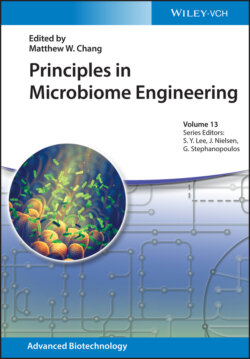Читать книгу Principles in Microbiome Engineering - Группа авторов - Страница 31
1.2.3 Age Groups and Dietary‐Related Microbiome Changes
ОглавлениеThe composition of the average human's microbiome changes over the span of their lifetime, where these changes are attributed to the individual's basal metabolic rate (BMR), host biochemistry, lifestyle, and dietary habits. The BMR of an average individual peaks around the late teenage years and declines as the individual ages. Coupled to the eating habits, the gut microbiota changes depending on these factors, where the composition of the gut microbiota shows vast differences at different growth stages (Figure 1.3).
Figure 1.3 The composition of the gut microbiome in people at different age stages.
Source: Based on Koenig [110] and Biagi et al. [111]
.
The initial development of the human gut microbiota is shaped during birth through microbial colonization introduced by the environment. During gestation, fetuses are generally considered germ‐free in utero, where the gut microbes of the individual microbiota are introduced post‐delivery. The microbiome is shaped by initial microbes introduced during childbirth, where infants delivered through natural birth and Caesarean‐section (C‐section) have different microbiota composition [18, 112, 113]. The GI tract of infants delivered by natural birth is primarily colonized by maternal vaginal and fecal bacteria with the enriched abundance of Lactobacillus and Bifidobacterium spp. [114], whereas the GI tract of C‐section infants is colonized by other environmental bacteria [112]. The microbiome is further shaped by the infants' diet, where the breast‐fed infants have more heterogeneous microbiota with higher taxonomic diversity than formula‐fed babies [115]. These variations in the delivery method and diet contribute to the maturation of the infant's immune system through the gut microbiome development [116]. Breast‐fed infants have further exposed microbes present in the milk and breast surface, accounting for over 700 species of bacteria [117] made up primarily of Streptococci and Staphylococci [118]. Breast milk is also rich in complex oligosaccharides that stimulates the growth of beneficial microbial groups such as Staphylococci [118] and Bifidobacteria [119]. In comparison, the microbiota of formula‐fed babies adapts a microbiota similar to that of an adult, with an increased abundance of E. coli, Clostridium difficile, Bacteroides fragilis, and Lactobacilli [120, 121]. The microbiota during the age of 0–3 years old is highly dynamic, which stabilizes after the age of 3 years [122].
Children (3–10 years old) undergo massive changes in the microbiota composition, particularly due to the introduction of solid dietary foods. Food solids comprise various nutrients and fibers that facilitate the colonization of various microbial groups including butyrate producers such as Bacteroides and certain Clostridium species [110, 123]. The diet introduced during the pre‐adolescence phase influences how the microbiome takes shape, where children provided with a balanced diet (meat/fish, fruit, vegetables, eggs/beans, and bread/pasta) showed different microbiota shift compared to those given an unhealthy diet (processed, sugar‐rich, and fatty foods) [124]. A study conducted in Japan discovered that Ruminococcus and Bacteroides were found to be enriched in children provided with unprocessed foods (e.g. meat/fish, fruit), whereas Blautia and Clostridium were abundant in the GI tract of children provided with processed food. Additionally, micronutrients provided through nutritional beverages were found to influence the microbiota population. Children provided with the Growing Up Milk‐Lite (GUMLi) was found to have increased bifidobacterial abundance compared to natural bovine milk and other milk formulations [124], indicating that micronutrients can be used to alter the microbiota.
The microbiota diversity in adults is similar to the children gut microbiome, but varies in the abundance of the various groups where adults showed a lesser abundance of Actinobacteria, Bacilli, Bifidobacterium, Faecalibacterium spp., Clostridium cluster IV (Ruminococcaceae), and Bacteroidetes [125, 126]. Clostridium cluster XIVa (i.e. Butyrivibrio crossotus and related bacteria), Firmicutes, and Bacteroides were more abundant in adults than children [127–129]. Other phyla showing a lower abundance in average adults include Proteobacteria, Verrucomicrobiota, Actinobacteria, and Euryarchaeota; where the various microbiota members play a role in microbes maintaining the host immune homeostasis [130]. The adult microbiota is relatively stable but can be perturbed by changes in diet, physical activity, illness, and changes in hormonal cycles and medical therapies. Alternations of the microbiome may positively or negatively impact the host health, where the microbiome is linked to various medical issues [131]. This will be discussed in the following subchapter 1.3.
The composition of the intestinal microbiota of people in their golden age (>65 years) differs largely between individuals [132]. These microbiota differ even further compared to the diversity of core microbiota in younger adults [111, 132]. The gut microbiome of elderlies has increased abundance of facultative anaerobes (such as Proteobacteria and Bacilli) and decreased abundance of F. prauznitzii and Clostridium cluster XIVa bacteria. It was also reported that centenarian's microbiota shows decreased abundance of Bacteroides, Bifidobacterium and Enterobacteriaceae; and enriched Clostridium spp. abundance [133].
The composition of the microbiota is certainly influenced by age; however, the dietary habits during infancy and pre‐adolescence play an important role in shaping the diversity of the microbiota. The dysbiosis of the microbiota during adulthood alters the host biochemistry, resulting in the changes of the host immune system, behavior, and susceptibility to disease.
